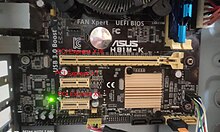
Back مسرى الربط السريع بين المكونات الطرفية Arabic PCI Express BS PCI Express Catalan PCI-Express Czech PCI Express German PCI Express Greek PCI-Express Esperanto PCI Express Spanish PCI Express Estonian پیسیآی اکسپرس Persian
| Peripheral Component Interconnect Express | |
 Logo | |
| Year created | 2003 |
|---|---|
| Created by | |
| Supersedes | |
| Width in bits | 1 per lane[1] (up to 16 lanes) |
| No. of devices | 1 on each endpoint of each connection.[a] |
| Speed | Dual simplex, up to 242 GB/s |
| Style | Serial |
| Hotplugging interface | Optional (support with ExpressCard, OCuLink, CFexpress or U.2) |
| External interface | Optional (support with OCuLink or PCI Express External Cabling) |
| Website | pcisig |


- PCI Express x4
- PCI Express x16
- PCI Express x1
- PCI Express x16
- Conventional PCI (32-bit, 5 V)
PCI Express (Peripheral Component Interconnect Express), officially abbreviated as PCIe or PCI-E,[2] is a high-speed serial computer expansion bus standard, meant to replace the older PCI, PCI-X and AGP bus standards. It is the common motherboard interface for personal computers' graphics cards, capture cards, sound cards, hard disk drive host adapters, SSDs, Wi-Fi, and Ethernet hardware connections.[3] PCIe has numerous improvements over the older standards, including higher maximum system bus throughput, lower I/O pin count, smaller physical footprint, better performance scaling for bus devices, a more detailed error detection and reporting mechanism (Advanced Error Reporting, AER),[4] and native hot-swap functionality. More recent revisions of the PCIe standard provide hardware support for I/O virtualization.
The PCI Express electrical interface is measured by the number of simultaneous lanes.[5] (A lane is a single send/receive line of data, analogous to a "one-lane road" having one lane of traffic in both directions.) The interface is also used in a variety of other standards — most notably the laptop expansion card interface called ExpressCard. It is also used in the storage interfaces of SATA Express, U.2 (SFF-8639) and M.2.
Formal specifications are maintained and developed by the PCI-SIG (PCI Special Interest Group) — a group of more than 900 companies that also maintains the conventional PCI specifications.
- ^ IBM Power 770 and 780 Technical Overview and Introduction. IBM Redbooks. 6 June 2013. ISBN 978-0-7384-5121-3.
- ^ Cite error: The named reference
s5NDGwas invoked but never defined (see the help page). - ^ Cite error: The named reference
DQmzvwas invoked but never defined (see the help page). - ^ Cite error: The named reference
gf9Lmwas invoked but never defined (see the help page). - ^ Cite error: The named reference
sxOenwas invoked but never defined (see the help page).
Cite error: There are <ref group=lower-alpha> tags or {{efn}} templates on this page, but the references will not show without a {{reflist|group=lower-alpha}} template or {{notelist}} template (see the help page).